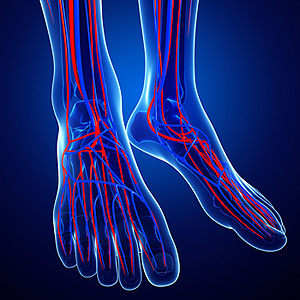The Dangers of Peripheral Artery Disease
Peripheral artery disease (PAD) is a condition that causes poor circulation in the lower limbs due to a blockage in the arteries that supply blood to them. PAD can be dangerous. If left untreated, it can progressively worsen, depriving your legs, ankles, and feet of blood and oxygen. Without them, the tissues of the lower limbs can become infected and die. Dead, infected tissue may lead to amputation or a potentially deadly systemic infection. Thankfully, PAD can be managed with proper medical treatment. Lifestyle changes, such as eating a healthy diet and exercising regularly, and taking certain medications can greatly reduce the risk of complications. Minimally invasive treatments and surgery can also be done to prevent complications in advanced cases. To learn more about PAD and to get tested, it’s a good idea to schedule an appointment with a podiatrist near you.
Peripheral artery disease can pose a serious risk to your health. It can increase the risk of stroke and heart attack. If you have symptoms of peripheral artery disease, consult with Anthony Ricciardi Jr., DPM from Foot & Ankle Specialists of Nevada. Our Doctor will assess your condition and provide you with quality foot and ankle treatment.
Peripheral artery disease (PAD) is when arteries are constricted due to plaque (fatty deposits) build-up. This results in less blood flow to the legs and other extremities. The main cause of PAD is atherosclerosis, in which plaque builds up in the arteries.
Symptoms
Symptoms of PAD include:
- Claudication (leg pain from walking)
- Numbness in legs
- Decrease in growth of leg hair and toenails
- Paleness of the skin
- Erectile dysfunction
- Sores and wounds on legs and feet that won’t heal
- Coldness in one leg
It is important to note that a majority of individuals never show any symptoms of PAD.
Diagnosis
While PAD occurs in the legs and arteries, Podiatrists can diagnose PAD. Podiatrists utilize a test called an ankle-brachial index (ABI). An ABI test compares blood pressure in your arm to you ankle to see if any abnormality occurs. Ultrasound and imaging devices may also be used.
Treatment
Fortunately, lifestyle changes such as maintaining a healthy diet, exercising, managing cholesterol and blood sugar levels, and quitting smoking, can all treat PAD. Medications that prevent clots from occurring can be prescribed. Finally, in some cases, surgery may be recommended.
If you have any questions, please feel free to contact our office located in Las Vegas, Nevada . We offer the newest diagnostic and treatment technologies for all your foot care needs.

